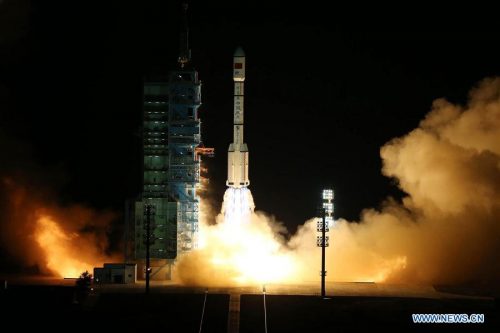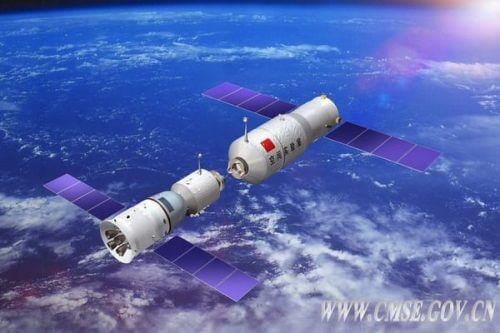The Chinese space station Tiangong 2, whose name means "heavenly palace" in Hebrew, was successfully launched this evening from the Jiuquan Space Port in the Gobi Desert in northwestern China at 22:04 (local time), aboard a Chinese Long March 2F launcher. By the end of next month, the manned spacecraft Shenzhou 11 will be launched to it, with two taikonauts on board. The experimental station will operate for about two years and will be another step towards the construction of a permanent Chinese space station in 2022.

The Shenzhou 11 spacecraft will be launched to the new station by the end of October, with two taikonauts (Chinese astronauts) on board, in China's first manned launch since the previous mission Shenzhou 10 in 2013. The spacecraft will dock with the new space station and the astronauts will stay on it for 30 days. This will be China's longest manned mission in space, with the previous mission to the Chinese space station Tiangong 1 lasting only 15 days.
In April 2017, the first Chinese cargo spacecraft, named Tianju 1 (Hebrew: "heavenly vessel"), will be launched to the station with the intention of testing the docking capabilities of the station with cargo spacecraft that will enable refueling in space and bringing supplies for a long-term stay in space, similar to the International Space Station that they arrive at frequent cargo spacecraft, allowing it to carry astronauts continuously since 2000.
At a press conference held yesterday (Wednesday), Wu Ping, deputy director of China's Manned Space Engineering Office, said the launch of Tiangong 2 is a "key step" on the way to the permanent Chinese space station, which according to the current schedule will be completed around 2022.
Tiangong 2 is similar in size and shape to the first Chinese space station, Tiangong 1. Its length is 10.4 meters, it has a maximum diameter of 3.4 meters and it weighs 8.6 tons. It is connected to two solar panels which, after deployment, will be 18.4 meters long from end to end. Compared to its predecessor, Tiangong 2 underwent many improvements designed to facilitate and extend the astronauts' stay in it. Among other things, the life support systems and the living environment at the station have been improved, and equipment for physical exercise has also been added to it.
Tiangong 2, which is designed to operate for about two years, carries a wide variety of scientific and medical experiments. Among other things, the station includes a detector for the study of gamma-ray bursts called POLAR, built by scientists from China, Poland and Switzerland.
Along with the station, a tiny satellite named Banxing-2 was launched that will fly parallel to the station and will be able to photograph it and its docking with the Shenzhou 11 manned spacecraft.

The spacecraft was launched into an initial orbit of about 200 km above the earth's surface, and gradually it will raise itself to a stable orbit at an altitude of about 380 km. While docking with the Shenzhou 11 manned spacecraft, it will raise itself further to an altitude of 393 km. According to Wu Ping, this is a significant improvement compared to Tiangong 1 which operated at an altitude of about 340 km, and another step towards higher altitude operation of the future space station. For comparison, the International Space Station is at an altitude of about 400 km.
If China adheres to the current schedule, in 2018 the first module of the permanent Chinese space station will be launched, which by 2022 will include three different modules and allow the docking of two manned spacecraft and a cargo spacecraft at the same time. China also plans to launch a space telescope with capabilities similar to those of the Hubble Space Telescope, which will be transported near the future station and can even dock with it.
Regarding the previous space station Tiangong 1, which is still in space, Wu Ping She said At the press conference yesterday that the station stopped transmitting data in March of this year. According to her, the station is now at an altitude of about 370 km and is expected to fall back into the atmosphere, probably uncontrollably, in the second half of 2017, although she noted that the chances of the fall causing damage are very low.

3 תגובות
It did not explode and the connection was not lost.